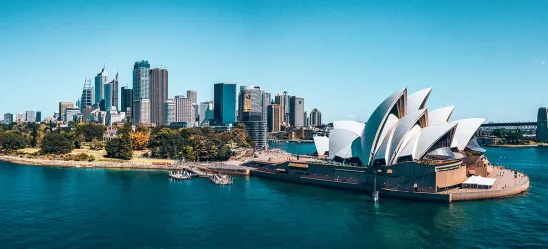Australia Real Estate Alert
In Part 7 of our build to rent (BTR) Series, we take a look at the current BTR market in Australia and the potential impacts of BTR developments on the residential sector.
A GROWING SECTOR
The most recent Australian Bureau of Statistics (ABS) data valued the total value of residential dwellings in Australia as at the March quarter 2023 as approximately AU$9.9 trillion based on a total of 11,020,300 residential dwellings in Australia.1
In contrast, Ernst & Young estimated the value of the BTR sector in Australia at AU$16.87 billion at a similar time,2 being a tiny fraction of the total value of the housing sector.
Much of this is explained by the relative infancy of the BTR sector in Australia, having been constrained by the tax and policy challenges outlined earlier in this series. There have been only a handful of completed BTR developments coming onto the market in the last few years, most of which were completed since the start of 2022.
The pipeline of BTR projects is however growing. There are 72 reported projects across Victoria, New South Wales, Queensland, and Western Australia.3 This figure will further increase with Australian and international developers, along with a number of institutional investors, announcing plans to capitalise on the unmet demand for residential housing through the BTR model.
In fact, Oxford Economics Australia has predicted that by the end of 2030, the Australian BTR sector will deliver an active stock of around 100,000 apartments, with a total valuation of approximately AU$100 billion.4 Oxford Economics Australia also expects investment in new BTR developments to surpass investment in other real estate asset classes.5
So, what are the potential impacts of an expanding BTR sector on existing residential markets?
IMPACTS ON HOME OWNERSHIP
Part 6 of our BTR Series discussed the benefits of BTR developments as an alternative to traditional residential leasing, including the potential for improved amenities and facilities as well as the ability to provide renters with increased supply.
A growing BTR sector also has the potential to disrupt the home ownership market.
Historically, Australians have shown a strong preference of ownership over renting. This culture of the “great Australian dream” may not change in the short term, but it is an ambition that has become increasingly less attainable.
ABS data indicates that 66% of Australian households owned their own home as at 2019-2020 (down from 71% in 1999-2000), with 31% of households renting.6 Australians are less likely to own a home at any age than previous generations. The rate of home ownership at the age of 30 has fallen from 65% for those born in the late 1950s to around 45% for those born in the 1980s.7
BTR may offer consumers with a more viable alternative to home ownership (relative to private residential renting), particularly in the context of an unprecedented housing affordability crisis.
BTR may be particularly attractive to younger generations, or those otherwise striving for new home or apartment ownership. From an amenity perspective, a BTR product (which, in Australia, has to date been predominantly pitched as a premium offering) will typically offer improved building and lifestyle facilities relative to common property in a subdivided building or housing estate. There is an incentive for the BTR building owner to maintain facilities to a high standard to ensure consistent rental demand, in contrast to common property in co-owned buildings or estates, where cost and administration considerations typically operate as barriers to maintenance (or improvement) of facilities over time.
A BTR building owner may also have greater capacity to enforce building amenity, in contrast to owners corporations (or equivalent), which may lack the power or capacity to manage impacts from, for example, short stay accommodation.
From a geographic standpoint, BTR developments are commonly located in desirable residential locations where the cost of new home ownership may otherwise be prohibitive. The current pipeline of BTR developments in Australia is overwhelmingly located in major cities, typically within five to seven kilometres of central business districts and close to transport and other infrastructure. This may be a significant lifestyle consideration where home ownership would otherwise force the consumer to look further afield.
While home ownership offers the consumer the ability to modify and customise their home, some of these benefits may also be available (to a more limited extent) in certain BTR offerings. For example, some BTR building owners may permit changes through painting, floor coverings or other modifications that provide the occupier with a greater sense of place.
This is more likely to be particularly the case in BTR communities that offer “Single Family Rentals” (known as SFR). SFRs are single family homes developed for the BTR sector and are becoming the focus of the BTR sector in jurisdictions such as the United States and the United Kingdom. Whilst apartment buildings prefer to maintain consistency of the facades (which can limit the extent units can be altered in a manner that is externally visible), this is less important in SFR communities.
The one aspect of home ownership, which cannot be replaced by BTR living, is the potential for capital growth. The connection, which Australians associate with home ownership and wealth, is well entrenched and has driven “the great Australian dream” for generations. Many Australians are, however, alive to the reality that purchasing a home today is not the automatic pathway to wealth that it may have been for past generations. The potential for more modest capital growth, a more volatile economic climate (both domestically and abroad) and, even, uncertainty around the taxation of home ownership into the future, may gradually wear away at the once overwhelming desire of Australians to own their own home.
All of these factors are, of course, considerations for the build to sell developer, whose competition may previously have been limited to established housing and competing build to sell product. The way in which build to sell offerings may respond to a growing BTR sector is something that will play out over time. At a minimum, it is reasonable to expect that the marketability of low quality or “investor grade” build to sell apartments may suffer. On the other hand, it may result in a positive shift towards better quality and better designed apartment buildings across the board.
CONVERSION OF OTHER ASSET TYPES - OFFICE, RETAIL AND SERVICED APARTMENTS
A significant barrier to any residential development is the sheer cost and risk of funding a new development, particularly in the face of building cost uncertainty and other pressures that impact typical residential development. The BTR sector is not immune from such pressures, notwithstanding the capacity to utilise innovative funding structures (such as fund through or take out models) not available to the residential build to sell developer.
There is also potential for the BTR sector to regenerate existing built form assets, such as underutilised office or serviced apartment buildings, by converting them into BTR products. In many cases, existing buildings may, due to technical servicing and other considerations, be unsuitable for subdivisional conversion to residential apartments (allowing individual apartment ownership), but may be suitable for BTR conversion.
The prevailing weakness in the lower grade commercial office market post-COVID presents particular opportunities. For example, recent research by the Property Council of Australia has identified approximately 90 office buildings in Melbourne’s central business district that have the potential to be transformed, creating up to 12,000 new homes.
In short, BTR may offer opportunities for investors to acquire and refurbish existing buildings, resulting in cost efficiencies and mitigating certain development risk. Of course, this will require the support of local councils and state governments to permit such conversions. Hopefully, that will be a natural response to changing demographic demands and housing needs.
If Australian developers embrace this strategy with the appropriate government support, this will mirror the growing pipeline of office-to-residential conversions that are occurring in the United States. Conversions in the United States are being fuelled by a convergence of factors including high office vacancy rates and a persistent shortage of housing. Office-to-residential conversions are also favoured by developers as floor area may be recaptured and used to add additional square footage in the building, which ultimately enhances the value of the investment.
Similarly, serviced apartments may provide an opportunity for conversion to BTR, with the potential that apartments may already meet applicable design guidelines or provide facilities that can be readily upgraded or converted to suit a BTR building. BTR conversion may also offer serviced apartment owners an opportunity to exit an oversaturated tourism sector in certain markets.
There is also potential opportunity for investors with existing retail holdings in prime locations to expand into BTR. Existing shopping centres and other major retail centres are likely to offer proximity to major transport, infrastructure, and employment and activity centres, which are attractive for BTR sites. The price for such land is typically a barrier for entry for BTR developments, but retailers may be able to capitalise on their landholdings to enter into the BTR market as a complement to their retail operations, to offer additional income and increase demand for retail tenants.
OLDER TENANTS AND RETIREMENT LIVING
BTR could also have a role in responding to Australia’s aging population. By 2031, people aged over 65 are projected to make up 19% of Australia’s population.8
The number of older Australians renting homes is also increasing. The percentage of people aged over 55 renting from a private landlord increased from 8% in 2011 to 11% in 2021.9
For BTR investors, older tenants may be seen as responsible tenants who provide a stable source of rental income. BTR developments may also be attractive to downsizing older Australians, providing the flexibility of a rental property, with the benefit of increased amenities, avoiding the need for home maintenance, potential lifestyle benefits provided by the location of the development and longer term tenure than traditional private rentals. While typical BTR models may require adaptation to be attractive to older Australians, ensuring adequate security of tenure and appropriately tailored facilities, there is potential for the sector to offer an alternative to traditional older person housing models such as retirement villages.
1 Australian Bureau of Statistics, Total Value of Dwellings, 13 June 2023.
2 Ernst & Young, A new form of housing supply for Australia: Build to Rent housing, 4 April 2023, page 18.
3 Ibid.
4 Oxford Economics Australia, Research Briefing: Roadblocks cleared for build-to-rent in Australia, 5 June 2023, page 6.
5 Ibid, page 5.
6 Australian Bureau of Statistics, Housing Occupancy and Costs, 25 May 2022; Australian Bureau of Statistics, More households renting as home ownership falls, 17 September 2019.
7Australian Housing and Urban Research Institute, Final Report No. 404: Transitions into home ownership: A quantitative assessment, July 2023, page 3.
8Australian Bureau of Statistics, Population Projections, Australia, 22 November 2018.
9Wendy Stone, Margaret Reynolds, Piret Veeroja, Emma R. Power, Francesca Perugia and Amity James, Ageing in a housing crisis: Older people’s housing insecurity & homelessness in Australia, August 2023, page 59.







 />i
/>i

